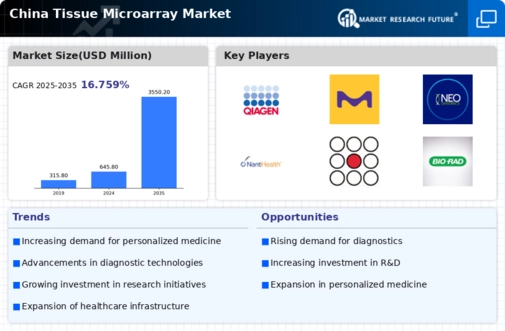Increasing Cancer Incidence
The rising incidence of cancer in China is a critical driver for the tissue microarray market. As cancer cases continue to escalate, the demand for advanced diagnostic tools, including tissue microarrays, is likely to increase. According to recent statistics, cancer is projected to affect approximately 4.6 million individuals annually in China by 2025. This alarming trend necessitates the development of innovative diagnostic solutions to enhance early detection and treatment strategies. The tissue microarray market is positioned to benefit from this growing need, as these technologies facilitate high-throughput analysis of tumor samples, enabling researchers to identify biomarkers and therapeutic targets more efficiently. Consequently, the increasing cancer burden in China is expected to propel the tissue microarray market forward, fostering advancements in cancer research and personalized treatment approaches.
Government Support and Funding
Government initiatives and funding programs in China are significantly influencing the tissue microarray market. The Chinese government has recognized the importance of biotechnology and medical research, allocating substantial resources to support innovation in these fields. For instance, the National Natural Science Foundation of China has been instrumental in financing research projects that utilize tissue microarray technologies. This financial backing not only encourages academic research but also stimulates collaborations between public institutions and private enterprises. As a result, the tissue microarray market is likely to experience accelerated growth due to enhanced research capabilities and the development of novel applications. The infusion of government funding is expected to lead to advancements in tissue microarray technologies, ultimately improving diagnostic accuracy and patient outcomes in the healthcare sector.
Rising Focus on Biomarker Discovery
The increasing emphasis on biomarker discovery in China is driving the tissue microarray market. Biomarkers play a pivotal role in the diagnosis and treatment of various diseases, particularly cancer. The tissue microarray market is well-suited to support this focus, as it allows for the simultaneous analysis of multiple tissue samples, facilitating the identification of potential biomarkers. Recent studies indicate that the market for biomarkers in China is anticipated to reach approximately $5 billion by 2026, reflecting a compound annual growth rate (CAGR) of around 12%. This surge in biomarker research is likely to enhance the demand for tissue microarrays, as researchers seek efficient methods to validate and characterize biomarkers. Consequently, the tissue microarray market is expected to thrive as it aligns with the growing need for innovative diagnostic tools in biomarker research.
Advancements in Research Infrastructure
The ongoing improvements in research infrastructure across China are positively impacting the tissue microarray market. Enhanced laboratory facilities, increased access to advanced technologies, and the establishment of research centers dedicated to cancer studies are contributing to a more conducive environment for tissue microarray applications. The tissue microarray market is benefiting from these advancements, as researchers gain access to state-of-the-art equipment and resources that facilitate high-quality research. Furthermore, collaborations between academic institutions and industry players are becoming more prevalent, fostering innovation and knowledge exchange. As research infrastructure continues to evolve, the tissue microarray market is likely to expand, providing researchers with the tools necessary to conduct comprehensive studies and drive scientific discoveries.
Growing Awareness of Precision Medicine
The rising awareness of precision medicine in China is a significant driver for the tissue microarray market. As healthcare professionals and patients increasingly recognize the benefits of tailored treatment approaches, the demand for technologies that support precision medicine is likely to grow. Tissue microarrays are instrumental in this context, as they enable the analysis of tumor heterogeneity and the identification of patient-specific therapeutic targets. The tissue microarray market is poised to capitalize on this trend, as healthcare systems seek to implement precision medicine strategies to improve patient outcomes. With the potential to enhance treatment efficacy and reduce adverse effects, the adoption of tissue microarrays is expected to rise, further propelling the market forward in the coming years.


















Leave a Comment